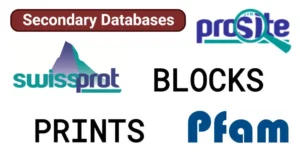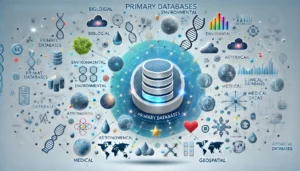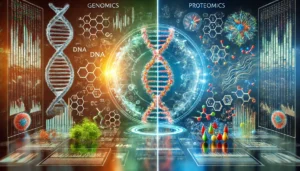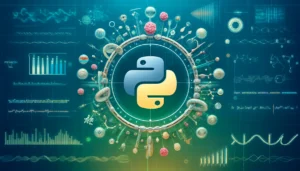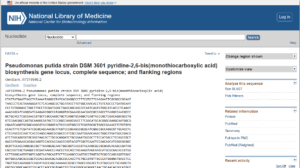Bioinformatics is a multidisciplinary field that integrates biology, computer science, and data analysis to extract meaningful insights from biological data. Essential components of bioinformatics include databases, software, and tools designed to handle, analyze, and visualize vast amounts of complex biological information.

1. Bioinformatics Databases
Bioinformatics databases serve as repositories for biological data, enabling researchers to access, share, and analyze information efficiently. They can be categorized into primary, secondary, and specialized databases.
Types of Bioinformatics Databases
- Primary Databases:
- Store raw, experimental data.
- Examples: GenBank, UniProt, PDB.
- Uses: Reference for molecular biology research, gene/protein analysis, and evolutionary studies.
- Secondary Databases:
- Contain curated data derived from primary databases.
- Examples: PROSITE, InterPro.
- Uses: Functional annotation of genes and proteins, motif detection.
- Specialized Databases:
- Focus on specific domains like pathways, interactions, or diseases.
- Examples: KEGG, Reactome, OMIM.
- Uses: Study of metabolic pathways, disease mechanisms, and functional networks.
Commonly Used Databases
- GenBank: Nucleotide sequences and annotations.
- UniProt: Comprehensive protein sequence and functional information.
- PDB: Structural data for proteins, nucleic acids, and complexes.
- KEGG: Pathways, genomes, and chemical compounds.
- GEO: Gene expression data sets from various experiments.
2. Bioinformatics Software
Bioinformatics software includes standalone programs and web-based tools used for analyzing biological data. These applications support diverse fields like genomics, proteomics, transcriptomics, and structural biology.
Types of Software
- Sequence Analysis Software:
- Tools: BLAST, Clustal Omega.
- Uses: Sequence alignment, similarity searches, phylogenetic tree construction.
- Structural Bioinformatics Software:
- Tools: PyMOL, Chimera.
- Uses: Visualization and analysis of protein/nucleic acid structures.
- Genomics and Transcriptomics Software:
- Tools: Bowtie, Cufflinks.
- Uses: Read alignment, gene expression analysis.
- Proteomics Software:
- Tools: Mascot, MaxQuant.
- Uses: Protein identification and quantification.
- Molecular Dynamics Software:
- Tools: GROMACS, AMBER.
- Uses: Simulating biomolecular systems, studying dynamic properties.
3. Bioinformatics Tools
Bioinformatics tools provide user-friendly interfaces for specific analyses and tasks, often integrating multiple software functionalities.
Commonly Used Tools
- BLAST (Basic Local Alignment Search Tool):
- Aligns nucleotide or protein sequences.
- Uses: Sequence similarity searching and annotation.
- Clustal Omega:
- Performs multiple sequence alignments.
- Uses: Comparative genomics and evolutionary studies.
- NCBI Genome Browser:
- Visualizes genomic data.
- Uses: Annotation of genes and variants.
- StringDB:
- Explores protein-protein interactions.
- Uses: Functional network analysis.
- Cytoscape:
- Constructs and visualizes biological networks.
- Uses: Pathway analysis, systems biology.
- AutoDock:
- Molecular docking software.
- Uses: Drug discovery and ligand-binding studies.
- GSEA (Gene Set Enrichment Analysis):
- Identifies enriched biological pathways.
- Uses: Functional annotation in transcriptomics.
4. Applications and Uses
Key Uses of Bioinformatics Databases, Software, and Tools
- Genomics:
- Genome annotation, variant analysis, and comparative genomics.
- Proteomics:
- Protein structure prediction, interaction analysis, and functional annotation.
- Drug Discovery:
- Virtual screening, target identification, and drug-ligand docking.
- Systems Biology:
- Modeling of metabolic pathways and biological networks.
- Evolutionary Biology:
- Phylogenetic analysis and studying conserved sequences.
- Clinical Research:
- Personalized medicine, biomarker discovery, and disease mechanism studies.
- Agricultural Sciences:
- Crop improvement, pest resistance, and plant genomics.
5. Advantages of Using Bioinformatics Tools
- Efficiency: Automates complex analyses.
- Accessibility: Freely available tools and databases for global researchers.
- Scalability: Handles large-scale datasets generated by high-throughput experiments.
- Integration: Combines diverse data types for comprehensive insights.
Conclusion
Bioinformatics databases, software, and tools form the backbone of modern biological research. Their efficient utilization facilitates the analysis of vast datasets, leading to groundbreaking discoveries in genomics, proteomics, systems biology, and beyond. Mastery of these resources empowers researchers to unlock new possibilities in biology, medicine, and biotechnology.


